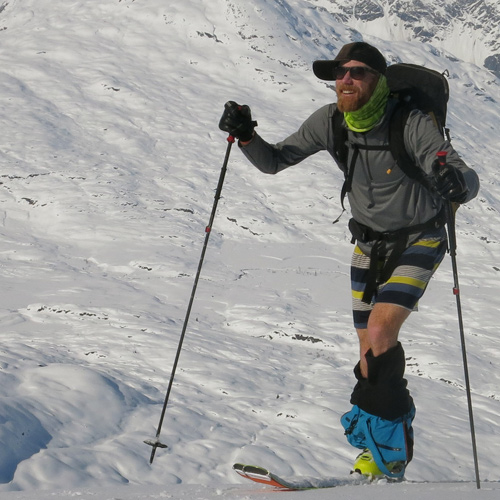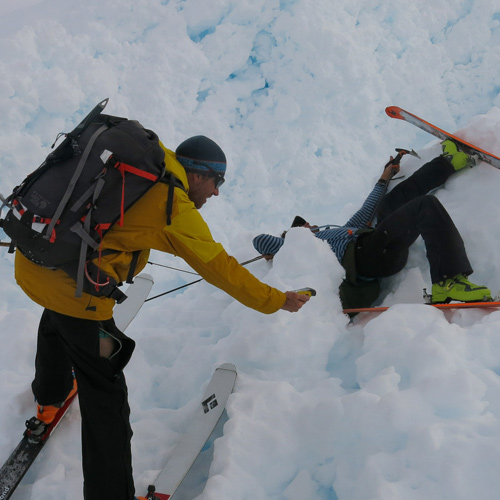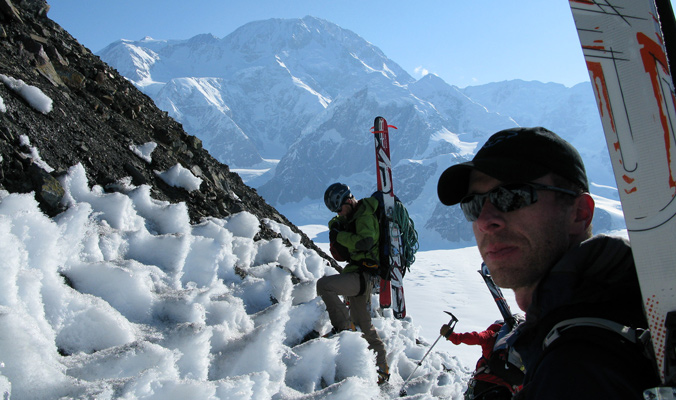In the ski mountaineering world, April is considered prime time for big descents. It is the chosen season for such objectives because avalanche stability is often at its seasonal high, days are longer, and the heat of summer has not yet started to wreak havoc on the snowpack. But this window of opportunity may be closing due to recent climate warming trends that might be here to stay.
On a trip to the Chugach Range in Alaska this month, ski mountaineer and writer Andrew McLean experienced unseasonably warm temperatures that made achieving his goals difficult, if not, at times, impossible. And when we heard about this less-than-ideal weather, we wanted to catch up with McLean to chat about how shifting climate trends may be changing the face of springtime ski mountaineering.
Here is what McLean had to say about Alaska this April.

You know it’s warm when the side vents on your pants aren’t doing the trick. [Photo] Andrew McLean
Andrew McLean: It [the trip] was to go to the Chugach Range, which is home of the famous Valdez and Thompson Pass skiing, which is traditionally excellent [in the spring]. We camped out at about 2,000 feet above sea level, which, in the beginning of April, is pretty much guaranteed to be cold. We were expecting temperatures down to minus 20 [degrees], and it was just the opposite. It was raining. It was at least plus 30 [degrees] and sometimes even hotter. A day of that wasn’t completely unusual, but the long period of extended warm weather was what really surprised a lot of people.
BCM: What were your concerns about how the warmth was affecting the snowpack?
AM: While we were there one of the days set a [temperature] record. It was something like 71 degrees. That was really unheard of. That set a state record. Then it never really cooled down. What happened was that the snowpack went from full winter mode to summer mode in the span of 10 days, and it made the snowpack completely isothermal, which is when it gets mucky. All of the air that has been trapped in it [the snowpack] during the winter from all the big, fluffy snowflakes just starts to warm up. It is not just the top layer but the entire snowpack that turns to mush.
It was so obviously warm that we stayed away from a lot of the slopes that were going to slide. It wasn’t just the south-facing slopes that traditionally get more sun. Pretty much every slope was pulling out because they were just shedding from the warmth.
That made it a really challenging trip because it was tough travel. It was hard to decide where to go; it was hard to find stuff that was steep enough to actually make turns on and yet not so steep that it was avalanching.

Andrew McLean searching for Glen Poulsen in a debris pile.
BCM: You like to plan ahead for your trips. How do you plan for this unseasonably warm weather?
AM: Traditionally what I have done in the past is just allot extra time for a trip. You can have storms that roll through for weeks on end, so if you want to ski for a week up there—seven days of skiing—you really need to plan to be up there for 14. So if I had stuck around, I am sure the skiing would have been better.
One solution would be to spend even more time up there. Or maybe you could go earlier, but earlier the weather has been so fickle. If you go earlier you have the chance of there being even more snow. One of the reasons I go in the spring is because the days are getting longer, the snowpack is the deepest, and it is generally a stable time. Whereas, if you go in the winter, you can get big variations, which makes for less stable snow.
BCM: Do you think this warming trend is here to stay?
AM: It is hard to say whether it has been a series of three, four or five bad years in a row or whether it’s a predominant trend. At this point I guess I will just take my chances and assume that the beginning of April is probably the prime time to go on a ski trip—but I am starting to questions that.
BCM: Let’s say this is a trend—what do you think that means for bigger ski mountaineering routes in the future?
AM: They [mountaineering routes] are definitely falling apart. The Caroline Face on Mt. Cook in New Zealand, that is a classic example. It has huge ice bulges and snow faces, and if they are all filled in and have enough snow, it makes those lines conceivably skiable. But when huge chunks of ice start falling out that have taken centuries to build up, who knows what’ll happen?
BCM: How would you change how you pack in the event we see more frequent warming trends in the spring?
AM: It is good to bring more synthetics, for sure. And maybe I’ll start looking at more waterproofing for tents. Cold, if you’re prepared for cold, is actually really good for camping because everything stays nice and frozen. You can bring in a bunch of food and it freezes. That’s great. So I would maybe need to change what kind of food I bring in. I would need to start bringing in tarps to put underneath tents because tents, usually if it’s rock hard and frozen, they don’t get all lumpy underneath. But if it starts to get warm and soggy, the moisture evaporates from the ground up. It just goes through the bottom of the tent. So I would need to have some sort of vapor barrier or tarp for the bottom of the tent. I also would potentially not need as many really warm clothes. That tends to be bulky. But, at the same time, you could have big temperature snaps. I would probably just end up bringing those.

Warm weather in Alaska means a hike through large suncups. [Photo] Andrew McLean
AM: Well, there are some good headlamps out there [laughs]. It depends on where you go. Springtime in Alaska gets seven more minutes of light per day. It is pretty much broad daylight by 6 a.m. I suppose skiing in the middle of the night would do it, but I’ll leave that to the next generation.
BCM: How do warming trends affect you understanding of what it means to be a backcountry skier?
AM: From a personal standpoint, as I sit there staring at the tent thinking about it, it starts to make me wonder about my contribution to it [climate change] and skiers in general. The idea of packing everything up, flying on a plane, getting together a bunch of gear to go skiing—maybe from a skiing standpoint the responsible thing would be to stay home and ski local. To have less of a carbon impact. I think that is a tough one to reconcile. On one hand, it’s easy to say that it’s big coal or someone else’s issue, but do you really need to go to Antarctica or Alaska to get some good skiing in?










I’ve only skimmed the article so far, but the “71 degrees” immediately jumped out. After reviewing the SNOTEL data for Thompson Pass so far in April 2016, the max temp was 50 degrees. For Valdez it is 55.